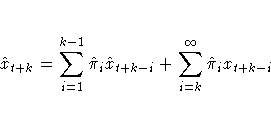Chapter Contents
Previous
Next
|
Chapter Contents |
Previous |
Next |
| The ARIMA Procedure |
If the model has input variables, a forecast beyond the end of the data for the input variables is possible only if univariate ARIMA models have previously been fit to the input variables or future values for the input variables are included in the DATA= data set.
If input variables are used, the forecast standard errors and confidence limits of the response depend on the estimated forecast error variance of the predicted inputs. If several input series are used, the forecast errors for the inputs should be independent; otherwise, the standard errors and confidence limits for the response series will not be accurate. If future values for the input variables are included in the DATA= data set, the standard errors of the forecasts will be underestimated since these values are assumed to be known with certainty.
The forecasts are generated using forecasting equations consistent with the method used to estimate the model parameters. Thus, the estimation method specified on the ESTIMATE statement also controls the way forecasts are produced by the FORECAST statement.
The series xt can be represented as

where
![]() .
.
The k-step forecast of xt+k is computed as

where unobserved past values of xt are set to zero,
and ![]() is obtained from the estimated parameters
is obtained from the estimated parameters
![]() and
and ![]() .
.
That is, the k-step forecast of xt+k, given (x1, ... ,xt-1), is

where Ck,t is the covariance of xt+k and (x1, ... ,xt-1), and Vt is the covariance matrix of the vector (x1, ... ,xt-1). Ck,t and Vt are derived from the estimated parameters.
Finite memory forecasts minimize the mean-squared error of prediction if the parameters of the ARMA model are known exactly. (In most cases, the parameters of the ARMA model are estimated, so the predictors are not true best linear forecasts.)
If the response series is differenced, the final forecast is produced by summing the forecast of the differenced series. This summation, and thus the forecast, is conditional on the initial values of the series. Thus, when the response series is differenced, the final forecasts are not true finite memory forecasts because they are derived assuming that the differenced series begins in a steady-state condition. Thus, they fall somewhere between finite memory and infinite memory forecasts. In practice, there is seldom any practical difference between these forecasts and true finite memory forecasts.
|
Chapter Contents |
Previous |
Next |
Top |
Copyright © 1999 by SAS Institute Inc., Cary, NC, USA. All rights reserved.